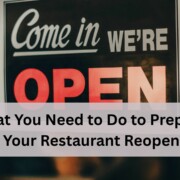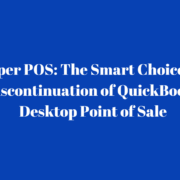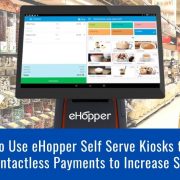How to Choose the Best POS System for Restaurants and Retail in 2025 [Download FREE POS Comparison Checklist]
If you’re a restaurant or retail operator, you know that finding the best Point of Sale (POS) system isn’t just a task on your to-do list—it’s a pivotal decision that can significantly impact the success of your business. The right POS system can streamline your operations, provide valuable insights, and ultimately, drive your business growth. But with so many options out there, how do you choose the best POS system that’s tailor-made for your unique needs?
That’s where we come in. We’ve created this comprehensive guide to help you navigate the sea of POS solutions and zero in on the one that’s perfect for your business. And to make your decision-making process even smoother, we’re offering a free POS Comparison Checklist.
This handy tool will allow you to compare different systems side by side, making it easier to identify the one that ticks all your boxes.
Whether you’re looking for a system that’s user-friendly, can support multiple locations, offers integrated payments, or excels in inventory, customer, and employee management, our guide and checklist have got you covered.
And the best part? You can use the checklist in any way you need, whether that’s to evaluate systems on your own time, to facilitate discussions with your team, or to negotiate with POS system providers.
So, let’s get started. You can also download the POS Comparison Checklist here.
Understanding POS Systems
Before we talk about the specifics of choosing the best POS system, let’s take a moment to understand what a POS system is and why it’s so crucial for your restaurant or retail business.
At its core, a POS system is a combination of hardware and software that manages sales transactions. But in today’s digital age, POS systems have evolved to do so much more. They’re not just cash registers anymore—they’re comprehensive business management tools that can streamline your operations and provide valuable insights to help your business grow.
For restaurant and retail operators, a POS system is like the central nervous system of your business. It processes sales, yes, but it also tracks inventory in real-time, manages customer relationships, handles employee scheduling and tasks, and generates reports that can give you a clear picture of your business’s performance. It’s the hub where all your business’s critical operations come together.
In essence, it is more than just a tool—it’s a partner in your business. It works around the clock, handling the nitty-gritty details of your operations so you can focus on what you do best: providing excellent products and services to your customers.
So, as you move forward in this guide and start comparing different POS systems, keep in mind that you’re not just looking for a tool to process sales. You are looking for a system that can support essential aspects of your business and help you achieve your goals.
Key Criteria for Choosing a POS System
As you move forward to find the best POS system for your restaurant or retail business, it’s important to have a clear understanding of the key criteria that a good POS system should meet. These criteria will serve as your compass, guiding you through the sea of options and helping you identify the system that truly aligns with your business needs.
They encompass various aspects of your operations, from daily transactions and inventory management to customer relationships and employee scheduling.
Let’s go over these key factors.
Ease of Use
When it comes to choosing the best POS system for your restaurant or retail business, one of the first things to consider is ease of use. After all, a POS system is meant to make your life easier, not more complicated.
A user-friendly system can be quickly adopted by your team, reducing training time and minimizing errors. It should have an intuitive interface that makes daily operations, from processing sales to managing inventory, a breeze.
Multi-location Support
If you’re operating in multiple locations or planning to expand your business, a POS system that supports multi-location operations is a must. This feature allows you to manage all your locations from a central system, providing a unified view of your sales, inventory, and customer data. It can help you maintain consistency across locations and make informed decisions about your business.
Integrated Payments
In today’s digital world, customers expect a variety of payment options. The best POS system for your business should be able to accept all major credit cards, debit cards, mobile payments, and even online payments. Integrated payments not only provide convenience to your customers but also streamline your transactions and keep your financial data organized. Learn more about free processing program to eliminate the credit card fees.
Support for Inventory, Customers, and Employees
A robust POS system goes beyond transactions. It should offer comprehensive support for managing your inventory, customers, and employees. Real-time inventory management can help you prevent stockouts and overstocks, customer management features can help you build strong relationships with your customers, and employee management features can help you track performance and optimize scheduling.
Self-Service Ordering
In the age of digital transformation, self-service ordering has become increasingly popular in the restaurant and retail industry. It offers customers a convenient and personalized shopping experience, while also helping businesses increase efficiency and reduce labor costs.
eHopper POS system offers integrated self-service ordering features, such as kiosks for restaurants or self-checkout for retail stores. If this is a feature you’re interested in, make sure to include it in your evaluation criteria.
Website with Online Ordering Capabilities
For retail businesses and restaurants, having a website with online ordering capabilities has become a necessity rather than a luxury. It allows you to reach more customers and provides a convenient shopping experience. eHopper POS offers mobile friendly e-commerce features. This ensures that your online and offline sales are synchronized, making inventory management easier and providing a unified shopping experience for your customers.
POS Hardware
While the software is the brain of your POS system, the hardware is the body. It’s the tangible part that your employees and customers interact with. Depending on your business needs, your POS hardware might include a cash drawer, receipt printer, barcode scanner, credit card EMV terminal, All-in-One POS Hardware and, of course, a computer or tablet to run the POS software. When choosing the best POS system for your business, consider the reliability and durability of the hardware, as well as how well it integrates with the software.
Customer Support and Pricing
Customer support and POS pricing are two other critical factors to consider. The best POS system providers offer reliable, round-the-clock customer support to help you resolve any issues that may arise. In terms of pricing, look for a system that offers transparent, value-for-money pricing plans that fit your budget and business needs.
Scalability and Cloud-Based Mobility
Finally, consider the system’s scalability—can it grow with your business? As your business expands, your POS system should be able to adapt and handle increased demand. Additionally, a cloud-based system offers the advantage of mobility, allowing you to access your business data from anywhere, anytime.
Key Criteria for Restaurants
For restaurant operators, there are several additional key criteria to consider when choosing the best POS system. These features are specifically designed to streamline restaurant operations and enhance the dining experience for your customers.
Table Management
A good restaurant POS system should include table management features. This allows you to keep track of which tables are occupied, which are free, and how long guests have been at their table. eHopper POS, for example, provides a visual floor plan, so you can easily manage your dining room at a glance.
Integrated Kitchen Display System (KDS)
An integrated KDS can significantly improve your restaurant’s efficiency. Orders are sent directly from the POS to the kitchen display, reducing errors and speeding up service. Your kitchen staff can see all the orders at once, know exactly when each was placed, and plan their cooking accordingly.
Loyalty Programs
Customer loyalty programs are a great way to reward your regular customers and encourage repeat business. Top POS systems for restaurants include features that allow you to set up, manage, and track your own loyalty programs.
QR Code Ordering
With the rise of contactless dining, QR code ordering has become increasingly popular. Customers simply scan a QR code at their table to view the menu and place their order on their phone. This feature can provide a safer dining experience and reduce the workload for your staff.
Depending on the specific needs of your restaurant operations, additional factors to consider when choosing a POS may include the ability to manage and track tips, monitor ingredient usage and inventory, and track the status of orders in real-time.
Key Criteria for Retail Stores
For retail store operators, managing inventory efficiently and effectively is a critical part of running a successful business. Therefore, when choosing a point of sale system for your retail store, there are specific inventory management features you should look for:
Stock Management
A robust POS should offer comprehensive stock management features. This includes tracking inventory levels in real-time, automating reordering processes, and providing insights into your best-selling products. Efficient stock management can help you prevent stockouts and overstocks, optimize your inventory turnover, and ultimately, increase your profitability.
Matrixes for Variants
If you sell products that come in different variants, such as color, size, and style, you’ll need a POS that can handle matrixes. This feature allows you to track each variant as a separate inventory item, making it easier to manage your stock and understand which variants are selling well and which are not.
Alerts for Low Stock Levels
To prevent stockouts, POS should offer alerts for low stock levels. You can set a threshold for each product, and when the stock level falls below this threshold, the system will alert you so you can reorder in time.
In the next section, we’ll discuss how to use our free POS Comparison Checklist to evaluate different systems based on these criteria.
Point of Sale (POS) Comparison Checklist
At eHopper, we’re committed to your success and believe in full transparency when it comes to helping you choose the right POS system for your business. We understand that this decision is a critical one, given the significant role a POS system plays in your operations. With a myriad of options available, the selection process can be complex. That’s why we’ve put together this comprehensive POS Comparison Checklist.
Our goal is to guide you through the POS landscape, simplifying the process and helping you select the most effective solution for your unique needs.
How to Use eHopper’s POS Comparison Checklist
Using our POS Comparison Tool is simple. Just follow these steps:
1. Download the Point of Sale (POS) Comparison Checklist.
2. Based on your business type, select the Restaurant POS or Retail POS tab.
3. Mark ‘yes’ or ‘no’ for each feature that the POS system you’re researching offers.
4. Add the pricing that the POS system you’re researching offers.
5. Compare the count under the number of “yes” and “no” responses.
6. Feel free to add additional features if needed.
Remember, the best POS system for your business is the one that meets your unique needs and fits within your budget. Our POS Comparison Tool is here to help you make an informed decision. Happy comparing!
For any questions or suggestions, contact us at sales@ehopper.com or schedule a free POS demo. We’re here to help you find the best POS system for your business.
![How to Choose the Best POS System for Restaurants and Retail [Download FREE POS Comparison Checklist]](https://ehopper.com/wp-content/uploads/free-pos-comparison-checklist-for-best-post-845x321.jpg)







